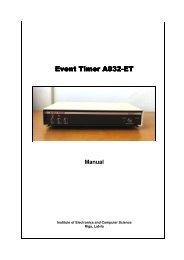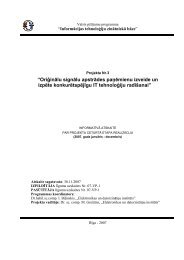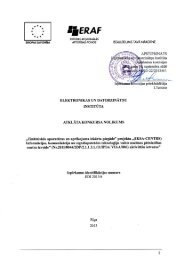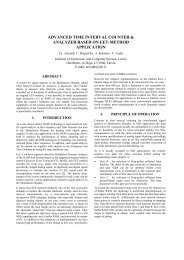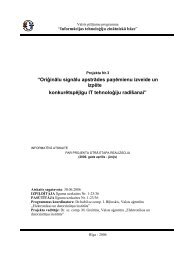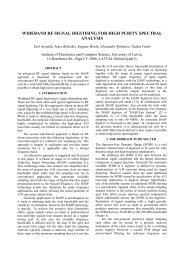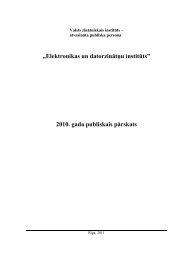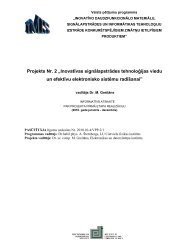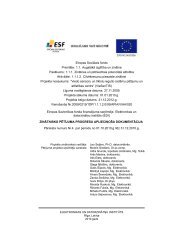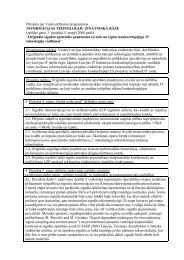Multiband signal processing by using nonuniform sampling and ...
Multiband signal processing by using nonuniform sampling and ...
Multiband signal processing by using nonuniform sampling and ...
Create successful ePaper yourself
Turn your PDF publications into a flip-book with our unique Google optimized e-Paper software.
<strong>Multib<strong>and</strong></strong> <strong>signal</strong> <strong>processing</strong> <strong>by</strong> <strong>using</strong> <strong>nonuniform</strong> <strong>sampling</strong> <strong>and</strong><br />
iterative updating of autocorrelation matrix<br />
Modris Greitāns<br />
Institute of Electronics <strong>and</strong> Computer Science, University of Latvia,<br />
Latvia<br />
E-mail: modris@edi.lv<br />
Abstract<br />
The approach to multib<strong>and</strong> <strong>signal</strong> <strong>processing</strong> is considered.<br />
The method discussed in this paper is<br />
based on <strong>nonuniform</strong> <strong>sampling</strong>, Minimum Variance<br />
filter <strong>and</strong> iterative updating of autocorrelation matrix.<br />
That allows to process a multib<strong>and</strong> <strong>signal</strong> even<br />
if the number of known <strong>signal</strong> samples is less than<br />
equivalent of Nyquist criterion for uniform <strong>sampling</strong>.<br />
The proposed approach of multib<strong>and</strong> <strong>signal</strong> <strong>processing</strong><br />
is suitable for spectral analysis, estimation of<br />
power spectral density <strong>and</strong> autocorrelation functions<br />
as well as for <strong>signal</strong> reconstruction. The information<br />
about the limits of the <strong>signal</strong>’s subb<strong>and</strong> frequencies<br />
gives the possibility to reconstruct the waveform of<br />
each <strong>signal</strong> part separately. It means that the suggested<br />
multib<strong>and</strong> <strong>signal</strong> <strong>processing</strong> method provides<br />
also some capability of <strong>signal</strong> subb<strong>and</strong> filtering. The<br />
performance of the method is illustrated <strong>by</strong> the conjoint<br />
GSM900 <strong>and</strong> GSM1800 <strong>signal</strong> <strong>processing</strong> example.<br />
1 Introduction<br />
Often the multib<strong>and</strong> <strong>signal</strong> <strong>processing</strong> is based on calculation<br />
of special <strong>sampling</strong> series in accordance with<br />
the <strong>signal</strong> spectral region location [1]. The possibility<br />
of achieving the minimum <strong>sampling</strong> density (equivalent<br />
of the Nyquist rate for uniform <strong>sampling</strong>) depends<br />
on possibility to tessellate frequency space <strong>by</strong><br />
a group of translations. In general, the calculated<br />
<strong>sampling</strong> instants of a multib<strong>and</strong> <strong>signal</strong> are spaced<br />
<strong>nonuniform</strong>ly therefore any changes of the <strong>signal</strong> subb<strong>and</strong><br />
limits leads to the necessity to recalculate <strong>signal</strong><br />
<strong>sampling</strong> series.<br />
This paper discusses the multib<strong>and</strong> <strong>signal</strong> <strong>processing</strong><br />
if arbitrary <strong>nonuniform</strong> <strong>sampling</strong> series is used. If<br />
it has a quality of frequency aliasing suppression [2],<br />
then there are no special requirements regarding the<br />
exact values of the <strong>sampling</strong> moment. Only two general<br />
conditions should be considered – the maximum<br />
gap between two known samples <strong>and</strong> the <strong>sampling</strong><br />
density should be conformed to the equivalent <strong>signal</strong><br />
b<strong>and</strong>width [3, 4].<br />
Traditionally, <strong>signal</strong> <strong>processing</strong> methods take into<br />
account only one parameter of <strong>signal</strong> power spectral<br />
density (PSD) function P (f), namely, the frequency<br />
boundaries of the spectrum. If such limits do exist,<br />
the <strong>signal</strong>s are called b<strong>and</strong>-limited <strong>signal</strong>s. The<br />
PSD function of a multib<strong>and</strong> <strong>signal</strong> consists of several<br />
separate frequency regions. It can take different<br />
appearance within these spectral subb<strong>and</strong>s. One way<br />
to characterize the form of PSD is to use the equivalent<br />
b<strong>and</strong>width of the b<strong>and</strong>-limited <strong>signal</strong> defined as<br />
[3]<br />
σ e =<br />
∫ ∞<br />
−∞ P (f)df<br />
max(P (f)) . (1)<br />
It is obvious that for real applications the value<br />
of the equivalent <strong>signal</strong> b<strong>and</strong>width is usually smaller<br />
than the actual <strong>signal</strong> b<strong>and</strong>width. Therefore, as it<br />
is shown in [4], <strong>nonuniform</strong> <strong>sampling</strong> allows to process<br />
<strong>signal</strong>s employing less <strong>signal</strong> samples than it is
equired <strong>by</strong> the Nyquist criterion in conformity with<br />
the cumulative <strong>signal</strong> b<strong>and</strong>width.<br />
2 Processing method<br />
The existence of several subb<strong>and</strong>s in a multib<strong>and</strong> <strong>signal</strong><br />
spectrum determines the necessity for developing<br />
of a special <strong>processing</strong> method taking into account<br />
the information about the boundaries of the <strong>signal</strong><br />
frequency regions. The suggested multib<strong>and</strong> <strong>signal</strong><br />
<strong>processing</strong> approach is based on the Minimum Variance<br />
method [3, 5]. The basic idea of this method<br />
is to minimize the variance of the narrowb<strong>and</strong> filter<br />
output <strong>signal</strong>. The frequency response of this filter<br />
adapts to the input <strong>signal</strong> spectral components on<br />
each frequency of interest. The variance of the output<br />
process is determined as:<br />
ρ = a H Ra, (2)<br />
where a is the vector of filter coefficients, while R is<br />
the <strong>signal</strong> autocorrelation matrix. In addition, filter<br />
coefficients should guarantee that on the frequency<br />
f 0 the gain of the filter response will be one. This<br />
condition could be described as:<br />
e H (f 0 )a = 1, (3)<br />
where e i (f 0 ) = exp(j2πf 0 t i ). On the other h<strong>and</strong>, the<br />
expression (3) means that a sinusoid at frequency f 0<br />
passes through the filter designed for this frequency<br />
without distortion. It is shown in [6] that the coefficients<br />
of the filter under condition (3) for the frequency<br />
f 0 are determined as:<br />
a(f 0 ) =<br />
R −1 e(f 0 )<br />
e H (f 0 )R −1 e(f 0 ) . (4)<br />
Taking into account expression (3), the output s of<br />
the designed filter<br />
s(f 0 ) = xa(f 0 ) (5)<br />
can be interpreted also as a complex spectral value<br />
(analogous of Fourier transform value) of <strong>signal</strong> x on<br />
the frequency f 0 [7]. Therefore the PSD value of the<br />
<strong>signal</strong> on this frequency can be calculated as<br />
p(f 0 ) = s(f 0 )s ∗ (f 0 ). (6)<br />
For the multib<strong>and</strong> <strong>signal</strong> <strong>processing</strong> task, each <strong>signal</strong><br />
subb<strong>and</strong> should be covered <strong>by</strong> the set of such filters.<br />
The distance between filter frequencies can be<br />
chosen equal to the frequency step of Discrete Fourier<br />
transform (DFT) – ∆f = 1 Θ<br />
, where Θ is the length<br />
of the <strong>signal</strong> to be analyzed.<br />
According to expression (4) the filter coefficients<br />
depend on the <strong>signal</strong> autocorrelation matrix. Usually<br />
the values of this matrix are not known a priori.<br />
Therefore the estimates of autocorrelation matrix<br />
values should be calculated from known <strong>signal</strong><br />
samples. The traditional approach for obtaining correlation<br />
matrix is based on averaging of the mutual<br />
products of <strong>signal</strong> samples. It is not applicable in<br />
the <strong>nonuniform</strong> <strong>sampling</strong> case, because the time intervals<br />
between <strong>sampling</strong> points are not distributed<br />
regularly. Instead of that the cross-relation of <strong>signal</strong>’s<br />
autocorrelation <strong>and</strong> power spectral density functions<br />
R(τ) =<br />
∫ ∞<br />
−∞<br />
P (f)e j2πfτ df (7)<br />
is employed for R calculation [8]. Moreover, the<br />
expression (7) allows to take into account also the<br />
known values of <strong>signal</strong> spectral subb<strong>and</strong>s, because<br />
the integration should be done only in the defined<br />
frequency regions. The most popular <strong>and</strong> simple way<br />
to obtain P (f) estimate from <strong>signal</strong> samples in the<br />
<strong>nonuniform</strong> <strong>sampling</strong> case is to use DFT.<br />
In accordance with approach described above the<br />
spectral analysis is performed in the fixed set of frequencies<br />
f = [f 1 , f 2 , ...f M ]. The known <strong>signal</strong> values<br />
x = [x 1 , x 2 , ...x N ] are sampled at defined time<br />
instants t = [t 1 , t 2 , ...t N ]. There<strong>by</strong> the values of autocorrelation<br />
function can be obtained as:<br />
ˆR (0) =<br />
ˆxE H 2<br />
∣ N ∣ E, (8)<br />
where E = exp(−j2πf m t n ) <strong>and</strong> ·(0) means that it<br />
is zero order estimate of R. Signal autocorrelation<br />
matrix values obtained <strong>by</strong> (8) are rather rough estimates<br />
that lead to rough estimation of <strong>signal</strong> complex<br />
spectral function values<br />
Ŝ (0) =<br />
E ˆR (0)−1 x T<br />
diag(ER (0)−1 E H )<br />
(9)
<strong>and</strong> PSD function values<br />
ˆP (0) =<br />
∣<br />
∣Ŝ(0) ∣ ∣∣<br />
2<br />
. (10)<br />
A special iterative updating algorithm, similar<br />
to described in [4, 7], is used to improve the results<br />
of <strong>processing</strong>. According to this algorithm the<br />
(i+1) − th order estimate of <strong>signal</strong> autocorrelation<br />
matrix is updated from the i−th order P (i) estimate<br />
in the following way<br />
m=M<br />
∑<br />
ˆR (i+1)<br />
lk<br />
=<br />
m=1<br />
ˆP (i)<br />
m E ∗ mlE mk . (11)<br />
Now, <strong>using</strong> matrix ˆR (i+1) , the estimates Ŝ(i+1) <strong>and</strong><br />
ˆP (i+1) can be calculated <strong>using</strong> expressions (9)-(10).<br />
In effect, an iterative algorithm has been derived.<br />
The iteration process (9)-(11) can be stopped when<br />
the difference<br />
∆ = ‖ ˆP (i+1) − ˆP (i) ‖<br />
becomes small.<br />
Although ˆR (i) is a positive definite symmetric matrix,<br />
it becomes ill conditioned as the number of the<br />
known samples increase [9]. In that case, the direct<br />
inversion of ˆR (i) leads to <strong>processing</strong> errors. Therefore<br />
the expression for obtaining PSD of <strong>signal</strong> could be<br />
derived as<br />
ˆP (i) =<br />
dx T 2<br />
∣diag(dE H ) ∣ , (12)<br />
where matrix d is solution of following matrix equation:<br />
ˆR (i) d = E. (13)<br />
The equation (13) could be solved <strong>by</strong> iterative<br />
methods [9, 10], for example, the conjugate gradient<br />
method.<br />
As it was mentioned above, the vector S can be<br />
interpreted as complex spectral values, therefore the<br />
inverse DFT could be used to obtain the values of<br />
reconstructed <strong>signal</strong> [7]. If the multib<strong>and</strong> <strong>signal</strong> <strong>processing</strong><br />
task is to perform some subb<strong>and</strong> filtering then<br />
for inverse DFT input only certain parts of estimated<br />
S values could be exploited.<br />
3 Example<br />
The conjoint GSM900 <strong>and</strong> GSM1800 <strong>signal</strong> <strong>processing</strong><br />
is chosen as an example of practical application of<br />
proposed multib<strong>and</strong> <strong>signal</strong> <strong>processing</strong> approach. The<br />
primary b<strong>and</strong> of GSM900 includes two subb<strong>and</strong>s of<br />
25 MHz each, 890-915 MHz for uplink (Mobile to<br />
Base) <strong>and</strong> 935-960 MHz for downlink (Base to Mobile).<br />
The GSM1800 includes the two domains 1710-<br />
1785 MHz <strong>and</strong> 1805-1880 MHz, i.e., twice 75 MHz:<br />
tree times as much as the primary 900 MHz b<strong>and</strong><br />
[11]. The central frequencies of the GSM channels are<br />
spread evenly every 200kHz within these b<strong>and</strong>s, starting<br />
200 kHz away from the b<strong>and</strong> borders. 124 different<br />
frequency slots are therefore defined in 25 MHz<br />
b<strong>and</strong>, <strong>and</strong> 374 in 75 MHz b<strong>and</strong>. The spectrum of<br />
the GMSK modulation used in GSM is somewhat<br />
wider than 200 kHz, resulting in some level of interference<br />
between bursts on adjacent frequency slots.<br />
Frequency planning must take the effect of adjacent<br />
channel overlapping into account. Therefore, in practice,<br />
not all of frequency slots are used in base station<br />
<strong>and</strong> the equivalent <strong>signal</strong> b<strong>and</strong>width usually is<br />
almost twice narrower than cumulative b<strong>and</strong>width.<br />
That provides the possibility to gain certain benefits<br />
from applying <strong>nonuniform</strong> <strong>sampling</strong> <strong>and</strong> <strong>using</strong> the<br />
discussed <strong>signal</strong> <strong>processing</strong> approach.<br />
The simulation example is considered, where altogether<br />
40 frequency slots are used simultaneously.<br />
The equivalent <strong>signal</strong> b<strong>and</strong>width in this case is approximately<br />
few tens of MHz, while total <strong>signal</strong> b<strong>and</strong>width<br />
to be processed is 200 MHz, because the positions<br />
of currently used frequency slots are not known.<br />
The equivalent of Nyquist rate for such a multib<strong>and</strong><br />
<strong>signal</strong> is 400 MSamples/s. Taken into account equivalent<br />
b<strong>and</strong>width for discussed example <strong>signal</strong>, the<br />
<strong>nonuniform</strong> <strong>sampling</strong> with 62.5 MSamples/s is exploited.<br />
The <strong>nonuniform</strong> <strong>sampling</strong> series is obtained<br />
from uniform <strong>sampling</strong> with frequency 4 GHz <strong>by</strong><br />
r<strong>and</strong>om selection 1<br />
64−th of <strong>sampling</strong> instants. That<br />
guarantees the necessary frequency aliasing suppression.<br />
The performance of proposed <strong>processing</strong> approach<br />
is compared with results obtained <strong>by</strong> <strong>processing</strong><br />
method based on Discrete Fourier transform. Figure<br />
1 shows the PSD estimate calculated as a
70<br />
70<br />
60<br />
60<br />
PSD (dB)<br />
50<br />
40<br />
50<br />
40<br />
30<br />
30<br />
20<br />
900 920 940 960<br />
1720 1740 1760 1780 1800 1820 1840 1860 1880 20<br />
frequency (MHz)<br />
Figure 1: PSD estimate from DFT of uniformly sampled (4 GSamples/sec) GSM <strong>signal</strong>.<br />
70<br />
70<br />
60<br />
60<br />
PSD (dB)<br />
50<br />
40<br />
50<br />
40<br />
30<br />
30<br />
20<br />
900 920 940 960<br />
1720 1740 1760 1780 1800 1820 1840 1860 1880 20<br />
frequency (MHz)<br />
Figure 2: PSD estimate from DFT of <strong>nonuniform</strong>ly sampled (62.5 MSamples/sec) GSM <strong>signal</strong>.<br />
70<br />
70<br />
60<br />
60<br />
PSD (dB)<br />
50<br />
40<br />
50<br />
40<br />
30<br />
30<br />
20<br />
900 920 940 960<br />
1720 1740 1760 1780 1800 1820 1840 1860 1880 20<br />
frequency (MHz)<br />
Figure 3: PSD estimate with iterative MV filter of <strong>nonuniform</strong>ly sampled (62.5 MSamples/sec) GSM <strong>signal</strong>.
squared module of FFT result from uniformly sampled<br />
(4 GHz) GSM <strong>signal</strong>. Eight sample series of<br />
131072 samples each are averaged without any additional<br />
windowing. The form of PSD estimate is<br />
affected <strong>by</strong> sidelobes from used frequency slots. Figure<br />
2 presents the PSD estimate obtained in a similar<br />
way, but 1 64−th of previously processed samples are<br />
left in r<strong>and</strong>om way <strong>and</strong> DFT instead of FFT is used.<br />
It is obvious that only high-powered frequency slots<br />
show up from noise floor originated <strong>by</strong> <strong>nonuniform</strong><br />
<strong>sampling</strong>. The described iterative multib<strong>and</strong> <strong>signal</strong><br />
<strong>processing</strong> approach eliminates both imperfections illustrated<br />
before - sidelobes of used frequency slots<br />
<strong>and</strong> noise floor of <strong>nonuniform</strong> <strong>sampling</strong>. It is demonstrated<br />
in the Figure 3. The PSD estimate clearly<br />
displays all used frequency slots frequency <strong>and</strong> relative<br />
power.<br />
4 Conclusions<br />
The simulation results confirm the applicability of<br />
discussed approach for multib<strong>and</strong> <strong>signal</strong> <strong>processing</strong>.<br />
The traditional multib<strong>and</strong> <strong>signal</strong> <strong>processing</strong> methods<br />
require specific calculation of <strong>sampling</strong> series in accordance<br />
with limits of <strong>signal</strong> frequency b<strong>and</strong>s. Instead,<br />
the proposed method operates with arbitrary<br />
<strong>nonuniform</strong> <strong>sampling</strong>, if it provides necessary frequency<br />
aliasing suppression. Moreover, the number<br />
of used <strong>signal</strong> samples could be significantly less then<br />
equivalent of Nyquist rate, if the equivalent <strong>signal</strong><br />
b<strong>and</strong>width is less than cumulative <strong>signal</strong> b<strong>and</strong>width.<br />
The serious disadvantage of method described in this<br />
paper is its complexity in the terms of required mathematical<br />
calculations due to iterative nature of obtaining<br />
estimates of power spectral density <strong>and</strong> autocorrelation<br />
functions.<br />
References<br />
[3] S. M. Marple Jr., Digital spectral analysis with<br />
applications, Prentice-Hall, 1987.<br />
[4] M. Greitans, “ Iterative Reconstruction of Lost<br />
Samples Using Updating of Autocorrelation Matrix”,<br />
in Proc. SampTA’97, Workshop on Sampling<br />
Theory & Applications, Aveiro, Portugal,<br />
pp. 155-160, Jun. 1997.<br />
[5] S. M. Kay <strong>and</strong> S. L. Marple Jr., “Spectrum analysis<br />
- a modern perspective”, Proc. of the IEEE,<br />
vol. 69, no. 11, pp. 1525-1578, 1981.<br />
[6] McDonough R. N., “Aplication of the<br />
Maximum-Likelihood Method <strong>and</strong> the<br />
Maximum-Entropy Method to Array Processing”,<br />
Chapter 6 in Nonlinear Methods of<br />
Spectral Analysis, 2nd ed., S. Haykin, ed.,<br />
Springer-Verlag, New Yourk, 1983.<br />
[7] V. Liepinsh, “An algorithm for estimation of discrete<br />
Fourier transform from sparse data”, Automatic<br />
control <strong>and</strong> computer sciences, vol. 29,<br />
no. 3, pp. 27-41, 1996.<br />
[8] J. S. Bendat, A. G. Piersol, Engineering applications<br />
of correlation <strong>and</strong> spectral analysis, John<br />
Wiley & Sons Inc., 1980.<br />
[9] A. K. Jain <strong>and</strong> S. Ranganath, “Extrapolation algorithms<br />
for discrete <strong>signal</strong>s with application in<br />
spectral analysis”, IEEE Trans. Acoust., Speech,<br />
Signal Processing, vol. ASSP-29, no. 4, pp. 830-<br />
845, 1981.<br />
[10] G. H. Golub <strong>and</strong> C. F. van Loan, Matrix computations,<br />
The Johns Hopkins University Press,<br />
Baltimore, 1989.<br />
[11] M. Mouly <strong>and</strong> M. B. Pautet, The GSM System<br />
for Mobile Communications, Cell & Sys, 1992.<br />
[1] J. R. Higgins, “Some gap <strong>sampling</strong> series for<br />
multib<strong>and</strong> <strong>signal</strong>s”, Signal Processing, vol. 12,<br />
no. 3, pp. 313-319, 1987.<br />
[2] I. Bilinskis <strong>and</strong> A. Mikelsons, R<strong>and</strong>omized Signal<br />
Processing, Prentice-Hall, 1992.




